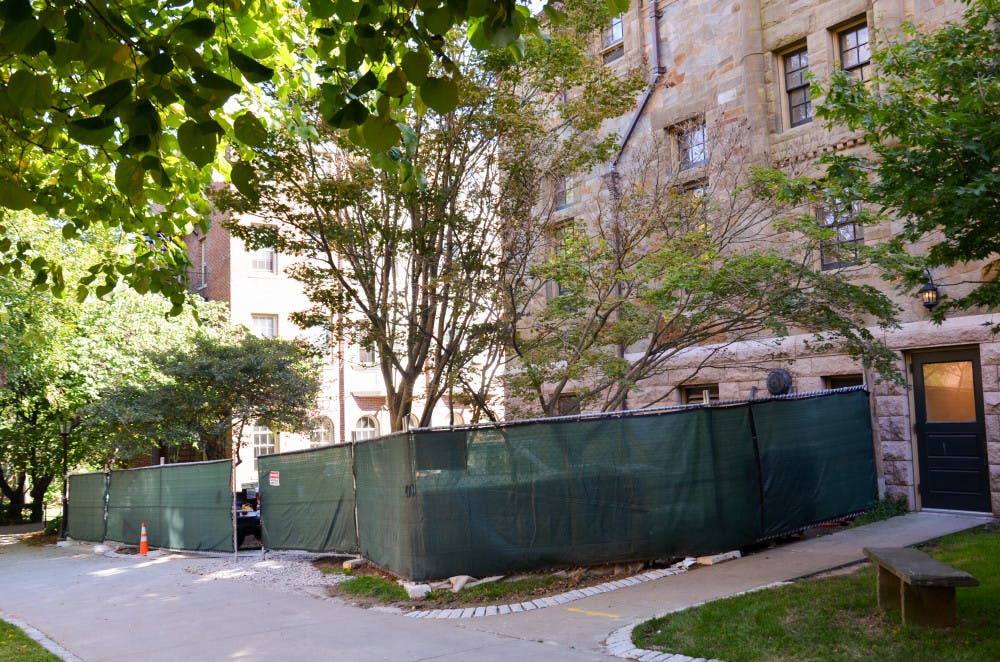As part of the University’s ongoing efforts to maintain buildings across campus, Wilson Hall, the Olney-Margolies Athletic Center, the Watson Institute for International and Public Affairs and the Geology-Chemistry Research Building have been slated to receive significant upgrades, said Vice President for Facilities Management Stephen Maiorisi.
Watson’s renovations will increase the physical space the institute commands, permitting it to accommodate a rapidly growing academic program. The renovation includes “a 20,000-square-foot new building in addition to the existing 10,000 square foot building,” Maiorisi said.
Construction on Watson will start June 2017 and should be completed by the end of 2018, said Michael Guglielmo, director of design and construction.
Wilson received a full exterior renovation five years ago, Guglielmo said. Yet it finds itself at the top of the renovations list now due to the need for interior renovations to make the building more accessible.
“We have a list of priority buildings (with accessibility issues) we have been compiling over the years with Wilson being one of them,” said Catherine Axe, assistant dean for student life and director of accessibility services.
Wilson’s renovation is particularly urgent given the number of classes that it hosts, Axe said.
“We currently move classes out of the building when people get injured mid-semester or people need wheelchair access,” she said. “This will allow for everyone to have a more seamless experience with their classes.”
The renovations to Wilson will also include a $2.5 million steam-hub conversion in addition to the renovation, Maiorisi added.
Wilson will be “offline” — meaning it will not be in use — from June 2017 to August 2018, he added.
A “working group” that includes the registrar and the dean of the College is developing a contingency plan for classroom spaces and meeting spaces while Wilson is under construction, Maiorisi said.
The OMAC renovations will include a new football locker room, new training facilities, additional equipment storage and laundry facilities, Guglielmo said.
“There have been very few enhancements or upgrades to the OMAC since it was built in 1981,” wrote Director of Athletics and Recreation Jack Hayes in an email to The Herald. “The renovation to the football locker room and the medical training room are needed in order to remain competitive with the other programs in the Ivy League.”
Hayes added that the current training room serves approximately 75 percent of student-athletes, and “providing them with a state-of-the-art facility for injury prevention and rehabilitation is a priority.”
The upgrades to the locker rooms in the OMAC are part of a series of locker room renovations, as some locker rooms in the Paul Bailey Pizzitola Memorial Sports Center were done over the summer, Maiorisi said.
Work on the OMAC will begin in November after the football season ends, with a completion date of August 2017, Guglielmo said.
Construction on the OMAC will take a “hybrid approach,” Guglielmo said. Some locker rooms within the footprint of the renovation will be permanently relocated to the second floor, while the football locker room and training room will be temporarily relocated while under construction, he added.
The GeoChem Building has proven difficult to upgrade over the years due to its configuration, Maiorisi said, adding that many upgrades have been deferred in order to do all of them at once.
Because it is such a large space, “we really cannot relocate people … while we are doing the work,” he said. This will require work to be done in the building while people are still there, he added.
Built in the 1980s, the building has several systems that need to be replaced, such as bathrooms and lab spaces, multiple sources said.
“The biggest issue for us is rather prosaic: air handling!” wrote Greg Hirth, chair of Earth, environmental and planetary sciences, in an email to The Herald. “Many of our lab experiments are influenced by temperature and humidity. The air handling for fume hoods also needs to be improved. There are also updates to fire safety that need to be made,” he added.
Designs for the GeoChem Building will start to take shape this fall, with construction slated to begin next summer, Guglielmo said.
There is no “hard finish” for the GeoChem building, as the project is expected to take a couple of years, and construction will have to “start and stop” to coordinate with ongoing research in the building, Maiorisi said.
“That will be the art of the deal on that particular project,” Guglielmo said. “One of the things we’re really good at is completing work around research and coordinating their activities so there is no — or minimal — downtime.”
The budget for the OMAC renovation is $8 million, Wilson will receive $18 million for its revamp in addition to the $2.5 million allocated for the utilities upgrade, and Watson and GeoChem will each have a budget of $25 million, Maiorisi said. The OMAC and Watson renovations are both “100 percent donor funded,” while Wilson’s renovation will likely be donor funded and Geochem’s is “not fundraised,” Maiorisi said.





